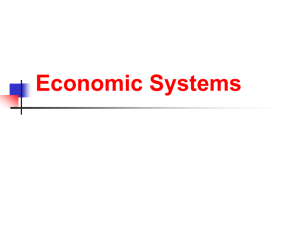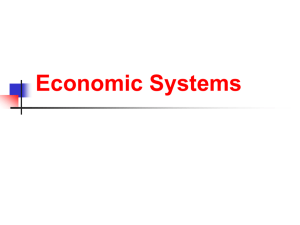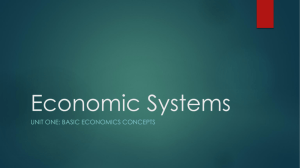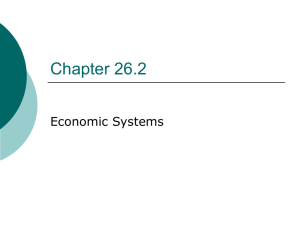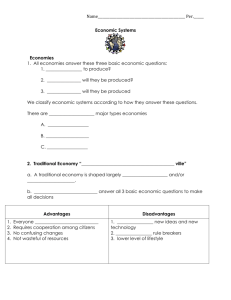Economic Systems
advertisement
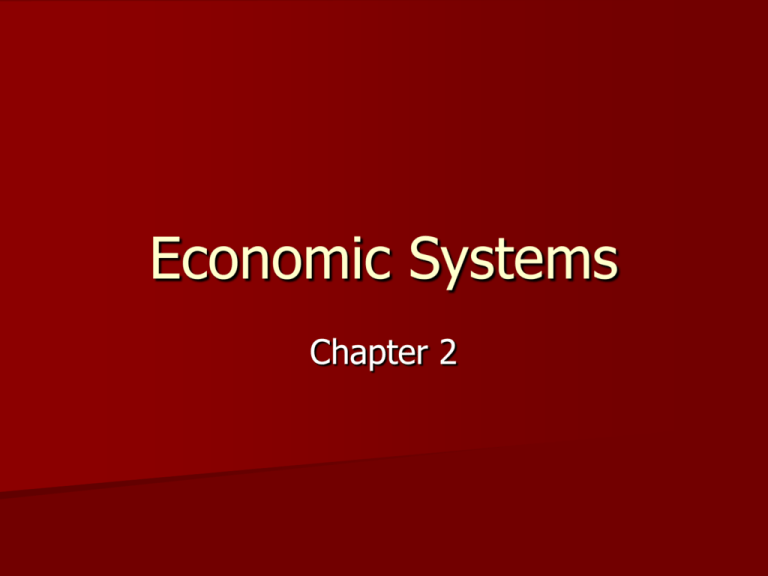
Economic Systems Chapter 2 Section 1 Economic System- the way society uses its scarce resources to satisfy unlimited wants Three systems- Traditional, Command, Market Economies Traditional Economy System where societies make economic decisions based on family, tribe, or clan customs and beliefs. Men and Women have set roles Men- hunt and herd animals Women- farm and take care of kids What do you think the advantages and disadvantages of this type of system may be? Advantages and Disadvantages of Traditional Economy Advantage- answers the three essential economic questions, What- enough to survive, How- follows tradition, For Whomdivided up through tradition Disadvantage- Systems are not changed, leads to less productivity. People are born into their role, lower standard of living Command Economy Gov’t decides what, how, and for whom to produce. Gov’t decides how to satisfy wants and needs of the consumer Basically, they control all aspects of economy Market Economy Individuals choice decides what, how, and for whom to produce. Consumer and producer drive this economy Roles of Consumers and Producers in Market Economies Consumer- spend money as they wish, enter into business with who they want, and buy work and services of others Producers- Decide what goods and services to sell and use limited resources to make as much money as possible Individuals in a market economy act in their own self interest when making economic decisions Producers make goods and services to make as much profit as possible Adam Smith’s Invisible Hand Theory When you make an economic decision you are acting in your own, best self interest, but at the same time you are unknowingly helping someone out. Section 2- Command Economics Gov’t decides what and how a good or service should be produced They determine wages, economic roles, and they make all decisions. They even tell you who can operate a business and how much they can sell a month Socialism and Communism These political systems are the best ex. of command economies Both were influenced by the historian and economist Karl Marx Karl Marx He believed the worker would overthrow the rich overtime and transfer the ownership of land and industry to the people. He believed that this would create a classless society. Marx and Engels Both Marx and Friedrich Engels laid out their economic philosophy in their book Communist Manifesto, in 1848 Marx wrote Das Kapital in 1867 to display his philosophy further. Marx’s theories do not work! He was trying to create a Utopian Society Socialism and Communism Socialism- economic system where the gov’t owns some or all of the factors of production, small business is individually owned Democratic Socialism- gov’t is put in place by the people, gov’t owns basic industries, but some are privately owned. Ex. Most European Nations Communismextreme form of socialism. Gov’t owns all factors of production, economy is controlled by communist party, and has absolute authority. Ex North Korea Advantages and Disadvantages Provide for sick and elderly Disadvantages- Central gov’t does not understand “local” problems No private property, leads to lack of motivation to use resources wisely Prices are set, leads to shortages No individual rights Section 3- Market Economies Market Economies revolve around people making decisions in their own self interest Private Property Rights and ownership enable this Private Property Rights- rights to groups and individuals who own property Ex. Factories, offices, clothes, music Markets Any place or situation where people have the right to buy and sell as they please, allows the enhancement of their own self interest. Markets can only work if we have well defined property rights Ex. Title to a car, copyrights, even receipts Without such property rights and laws the buyer could not trust the seller Market Economies Include Limited Gov’t Involvement All four factors of production are privately owned. Capitalism Most Economies including ours, has limited gov’t involvement Purest of capitalism is laissez faire, no gov’t involvement in the market place It does not exist in the real world Voluntary Exchange in Markets This is where both buyer and seller believe the worth of trade outweighs what they are giving up Ex. Car salesman and buyer, dealership makes profit Competition and Consumer Sovereignty Competition creates quality of goods and services and competitive prices Consumer Sovereignty- Consumers have ultimate control over what is produced, because they are free to buy what they want and reject what they don’t want What would happen if we did not have competition between sellers? Specialization and Markets We tend to specialize our time and effort into a job we can do best In turn, we take our wages to support our lifestyle This allows people to trade money for more efficiently made goods and services Ex. Teacher vs. Farmer Refer to Circular Flow Model Product Market Market for goods and services Household buys goods and services businesses sell, then they take their revenue to pay to keep their business going. Four Factors Market Businesses purchase the four factors(land, labor, capital, entrepreneurship) they need to sell goods and services In this market businesses are the buyers and households are the sellers. Advantages and Disadvantages of Market Economy Advantages Economic and political freedom Ability to make as much profit as possible Disadvantages They only invest in profit No military or social service spending Unable to work=no help Just rich and poor wage gap Section 4- Mixed Economies Most nations are a mix of traditional, command, and market economies Ex. U.S., gov’t protects consumers and regulates some areas of business Even command economies have mixed elements ex. China U.S. is more of a market system, contains private ownership and markets European nations economies are more mixed than ours European nations own key parts of their industry and in turn provide free healthcare and social assistance Fall of Communism=Free Markets in Eastern Europe Eastern Europe use to be under communist rule and Soviet influence Early 90’s Soviet Empire falls and eastern European nations begin to use market economics slowly Two Trends In Moving Towards Mixed Economy 1. Changes in Ownership These nations use to nationalize industry, gov’t owned and operated Now these former command economies have moved toward privatizationindividually owned by a person or group. This creates more efficiency and motivation to use resources wisely Why would a private business have more incentive to be more efficient and more productive compared to a business in a command economy? 2. Increasing Global Ties Globalization or Global Economy- opening your market and other to foreign investment Ex. U.S. and China Reasons for Globalized Economies Nations are investing in each other’s markets, stocks, bonds, etc. due to better telecommunications (internet and world wide web). Technological advancements in transportation of goods
